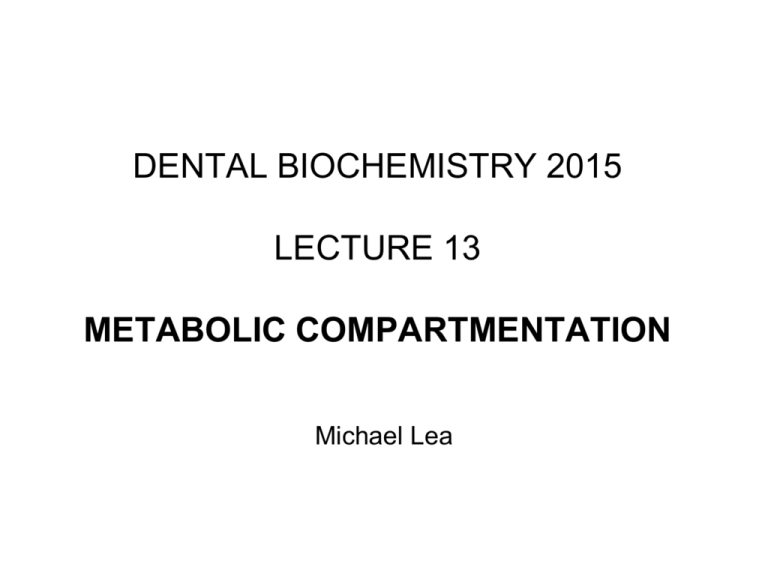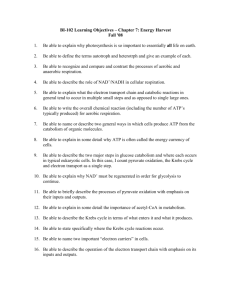METABOLIC COMPARTMENTATION
advertisement

DENTAL BIOCHEMISTRY 2015 LECTURE 13 METABOLIC COMPARTMENTATION Michael Lea LECTURE OUTLINE • Subcellular organelles in eukaryotic cells • Location of enzymes and metabolic pathways • Transport of metabolites across membranes • Glycerol phosphate and malate electron transport shuttles • Aerobic and anaerobic yields of ATP from glucose metabolism Suggested Reading • Lippincott’s Biochemistry, 6th edition, pages 79-80 EUKARYOTIC SUBCELLULAR ORGANIZATION Plasma membrane: hormone and cytokine recognition metabolite transport Cytosol: glycolysis pentose phosphate pathway lipid synthesis Mitochondrion: fatty acid oxidation TCA cycle electron transport oxidative phosphorylation Lysosome: hydrolases Peroxisome: peroxidation oxidation of very long chain fatty acids Endoplasmic Reticulum: protein synthesis xenobiotic metabolism Golgi: glycosylation, sulfation Nucleus: DNA synthesis RNA synthesis MOVEMENT OF METABOLITES ACROSS CELL MEMBRANES • Simple diffusion occurs with some small molecules • Facilitated diffusion accelerates movement but does not operate against a concentration gradient • Active transport requires ATP but can concentrate a molecule, e.g. some amino acid transport and the Na+/K+ ATPase • • • • ELECTRON SHUTTLES BETWEEN THE CYTOSOL AND THE MITOCHONDRIA The inner mitochondrial membrane is impermeable to NADH Electrons from NADH in the cytosol are transferred by electron shuttles. In the glycerol phosphate shuttle, NADH in the cytosol is used to reduce dihydoxyacetone phosphate in the reaction catalyzed by cytosolic glycerol 3-phosphate dehydrogenase. A glycerol phosphate oxidase in the inner mitochondrial membrane catalyzes the transfer of electrons from glycerol 3-phosphate to FAD. Reduced FAD is oxidized by Complex II in the mitochondrial electron transport chain. The malate-aspartate shuttle is an alternative mechanism for the transfer of electrons into mitochondria. VARIABLES AFFECTING THE YIELD OF ATP FROM THE OXIDATION OF A MOLECULE OF GLUCOSE • Aerobic or anaerobic conditions • Electron shuttle ( glycerol phosphate shuttle or malate aspartate shuttle) • Reduced coenzyme (NADH, 2.5 - 3 ATP or FADH2, 1.5 - 2 ATP) • The complete oxidation of glucose to carbon dioxide directly yields 2 ATP, 2 GTP, 10 NADH and 2 FADH. Depending on the assumptions used with respect to electron shuttle and ATP yield this could be the equivalent of 30 to 38 ATP molecules per molecule of glucose oxidized to carbon dioxide. Whatever the number, it is much greater than the net 2 molecules of ATP obtained from the anaerobic glycolysis of glucose to two molecules of lactic acid. LECTURE OBJECTIVES • After studying this lecture material you should be able to • Describe the subcellular localization of metabolic pathways in eukaryotic cells • Distinguish the different mechanisms by which metabolites cross cellular membranes • Understand the requirement for electron transport shuttles across the inner mitochondrial membrane and describe two mechanisms by which the transport is achieved • Appreciate the large difference in yields of ATP from glucose metabolism under aerobic and anaerobic conditions




